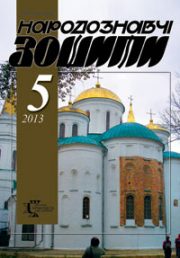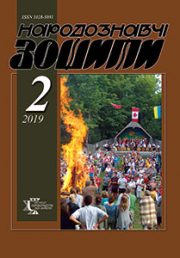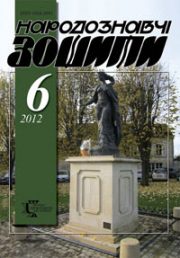The Ethnology Notebooks. 2022. № 1 (163), 87—96
UDK 002:641.5(477.83/.86)]:37-051Заклинська]:821.161.2-6Гануляк]
DOI https://doi.org/10.15407/nz2022.01.087
HISTORY OF THE CREATION OF THE BOOK OF OSYPA ZAKLYNSKA «NEW VITAMIN CUISINE»: BOOK SCIENTIFIC REVIEW
MOVNA Marianna
- ORCID ID: https://orcid.org/0000-0003-2473-6998
- Ph. D. of Historical Sciences,
- Researcher of the Vasyl Stefanyk
- National Scientific Library of Ukraine in Lviv
- National Academy of Sciences of Ukraine,
- in Department of Scientific Bibliography,
- 2, Stefanyka str., 79000, Lviv, Ukraine,
- Contacts: e-mail: mari3anna@ukr.net
Abstract. The Ukrainian cookbook of Galicia of the interwar twenty years, outlining its experience of food practices and gastronomic culture of that time, today arouses considerable not only scientific but also public interest, but still remains on the margins of historical and bibliographic studies. Meanwhile, she continued the best traditions of Ukrainian culinary book publishing in the second half of the XIX — early XX centuries.
The article first explores the history of the creation of a modern cookbook of the early XX century — «New Vitamin Cuisine» (1928) by O. Zaklynska. The figure of the author of the publication, which popularized the Ukrainian culinary discourse with its national traditions in their combination with the best examples of European cuisine, was also revealed.
The object of research is the history of O. Zaklynska’s cookbook, and the subject is the book itself. The research methodology is based on the application of the principles of scientificity, objectivity and historicism, and in the process of studying the material the problem-chronological and typological methods, the method of historical reconstruction and biography were used.
The main source for the disclosure of research topics was the epistolary of O. Zaklynska from the surviving family archive, which sheds light on the process of creating the book, its publishing nuances.
O. Zaklynska as an extraordinary figure of her time left a noticeable mark in the history of Ukrainian culture, and her «New Vitamin Cuisine» is interesting not only for its selection of recipes and translation of culinary experience in our time. As one of the nation-building factors, it establishes the necessary optics for the conceptual understanding of our historical past, because, through such an everyday thing as food, it not only reveals the past (Ukrainian culinary traditions), but also demonstrates the need for intergenerational memory in our culture.
Keywords: Osypa Zaklynska, «New Vitamin Cuisine», Hryhoriy Hanulyak, culinary discourse, Ukrainian, modern, epistolary, Galicia, beginning of the XX century.
Received 3.12.2021
REFERENCES
- Zaklynska, O. (2004). New Vitamin Cuisine. Lviv: Rusalka [in Ukrainian].
- [Zaklynska, Osipa]. (1926). A few words about running a kitchen. Nova Khata, 9, 18—19 [in Ukrainian].
- [Zaklynska, Osipa]. (1928). Our next task. Nova Khata, 6, 6 [in Ukrainian].
- Arsenych, P. (1995). The Zaklynsky family. Ivano-Frankivsk [in Ukrainian].
- Letter of D. Makogon to O. Zaklynska dated December 9, 1913, p. Lukavytsia, Chernivtsi district. Manuscript Department of the LNNB of Ukraine named after V. Stefanyka. F. 48 (Archive of the Zaklynsky family). Op. 1. File № 14. P. 8 [in Ukrainian].
- Makovsky, V. (Gmind). (1935, 10 august). Camp of Ukrainian coincidence and emigrants during the World War 1914—1918. Memories ahead of 20 years. Dilo, 211, 4 [in Ukrainian].
- Kusyj, L. (2020). Mykhailo Taranko — editor and publisher of literature for children and youth. Lviv [in Ukrainian].
- (1938, 7 June). General meeting of T-va VPUV. Dilo, 30 [in Ukrainian].
- Personal file of Zaklynska O.S. Archive of LNNB of Ukraine named after V. Stefanyka. Op. 3-axis. P. 114—119, 124 [in Ukrainian].
- Mykola Matviychuk’s letter to Bohdan Zaklynsky dated February 22, 1928, Lviv. Manuscripts Department of the LNNB of Ukraine named after V. Stefanyka. F. 48 (Archive of the Zaklynsky family). Op. 1. File 40. P. 27 [in Ukrainian].
- Letter of Hryhoriy Hanulyak to Bohdan Zaklynsky dated 27, 1928, Lviv. Manuscripts Department of the LNNB of Ukraine named after V. Stefanyka. F. 48 (Archive of the Zaklynsky family). Op. 1. File 25-g. P. 6 [in Ukrainian].
- Letter of Hryhoriy Hanulyak to Bohdan and Osypa Zaklynsky, 1928, Lviv. Manuscripts Department of the LNNB of Ukraine named after V. Stefanyka. F. 48 (Archive of the Zaklynsky family). Op. 1. File 25-g. Pp. 6, 8, 9, 10—12, 15 [in Ukrainian].
- (1929). Let’s eat as many vegetables and fruits as possible! Kolomyia [in Ukrainian].
- (1928). Let’s eat as much yarin as possible! Kolomyia [in Ukrainian].
- Letter of Hryhoriy Hanulyak to Osypa Zaklynska dated March 13, 1928, Lviv. Manuscripts Department of the LNNB of Ukraine named after V. Stefanyka. F. 48 (Archive of the Zaklynsky family). Op. 1. File 25-g. P. 8 [in Ukrainian].
- Letter from Oleksander Rybachevsky to Osypa Zaklynska dated March 30, 1928, Manuscripts Department of the LNNB of Ukraine named after V. Stefanyka. F. 48 (Archive of the Zaklynsky family). Op. 1.File 141. P. 2 [in Ukrainian].
- (1928, 1 april). «New vitamin cuisine. Dilo, 74, 5 [in Ukrainian].
- (1928, 1 october). [Advertising]. Dyakivski Vidomosti, 10, 4 [in Ukrainian].
- (1928, april). [Advertising]. Nova Khata, 4, 2 [in Ukrainian].
- [Hanulyak Hryhoriy]. [Review]. (1928). Illustrated economic calendar for 1929 (P. 68). Lviv [in Ukrainian].
- Olesnytska, S. (1928, 31 may). New books and edition. Dilo, 119, 4 [in Ukrainian].
- B., Stephanie (1928, 30 april). New cookbook. Novyj chas, 53, 6 [in Ukrainian].
- B., Stephanie (1928). [Review]. Illustrated economic calendar for 1929. Lviv: Rusalka [in Ukrainian].
- (1928). Our housewives for fun Illustrated economic calendar for 1929 (P. 65). Lviv: Rusalka [in Ukrainian].
- Advertising. (1928). Ukrainian terminar and calendar for 1929 (P. 11).Stanislaviv [in Ukrainian].
- Movna, M. Ukrainian cookbook of Galicia of the interwar twenty years: editions and figures. Notes of the Lviv National Scientific Library of Ukraine named after V. Stefanyk: collection of scientific works (in print) [in Ukrainian].







